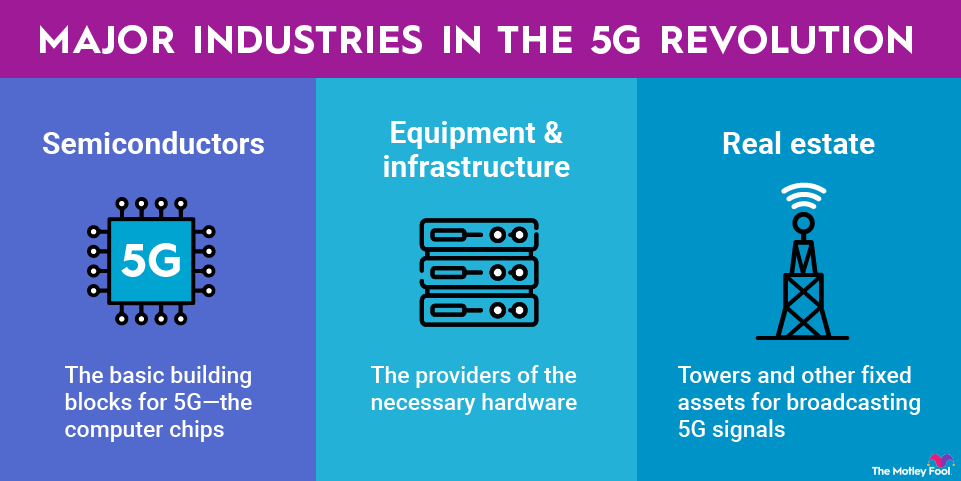The communications sector is broadly defined these days, encompassing everything from century-old legacy media companies to internet stocks. A communication services stock is a share in a company that facilitates the distribution of information and entertainment on a one-to-many or one-to-one basis.

Information technology companies use computers and software to help businesses and individuals stay connected. Telecommunications companies provide the infrastructure and services for distributing information. Television broadcast networks, broadband internet, and mobile wireless networks are also parts of the communications sector.
As we grow increasingly connected (and physically apart), the ability to send and receive information over distances becomes increasingly important. The communications sector will continue to produce important and valuable companies.
Best communications stocks in 2025
Here are five of the better stocks that are communicating with investors.
| Name and ticker | Market cap | Dividend yield | Industry |
|---|---|---|---|
| T-Mobile US (NASDAQ:TMUS) | $247.6 billion | 1.60% | Wireless Telecommunication Services |
| Comcast (NASDAQ:CMCSA) | $108.2 billion | 4.44% | Media |
| Netflix (NASDAQ:NFLX) | $473.2 billion | 0.00% | Entertainment |
| Alphabet (NASDAQ:GOOG) | $3.1 trillion | 0.32% | Interactive Media and Services |
| Meta Platforms (NASDAQ:META) | $1.8 trillion | 0.28% | Interactive Media and Services |
1. T-Mobile

NASDAQ: TMUS
Key Data Points
2. Comcast

NASDAQ: CMCSA
Key Data Points
Comcast (CMCSA -0.34%) is the largest cable television and internet service provider in the U.S. While its subscriber base is shrinking for both video and broadband internet, steady price increases and low costs make it very profitable. Its cable network is easy to maintain, and it can upgrade service with low incremental costs.
In 2018, the company acquired a majority stake in Sky, a leading pay TV operator in the U.K. and other European countries. It also operates a media company that produces sports, news, and entertainment television for its European audience.
Comcast’s NBCUniversal is one of the biggest media companies in the world. It includes global film and television productions, as well as a broad portfolio of U.S. cable and broadcast television networks. NBCUniversal also operates Peacock, a streaming service that gives it exposure to the direct-to-consumer media market.
Comcast plans to spin off NBCUniversal's cable TV networks, but retain the film and television studios, broadcast networks, theme parks, and streaming service.
Comcast is building a wireless phone business to offset losses in the cable business. So far, it's seen good traction by bundling subscribers, and now counts more than 8.5 million subscribers.
3. Netflix

NASDAQ: NFLX
Key Data Points
4. Alphabet

NASDAQ: GOOGL
Key Data Points
The core of Alphabet (GOOG +0.47%)(GOOGL +0.54%) is Google, which encompasses its namesake leading internet search engine, YouTube, Gmail, Android, and more. Google’s services are used by billions of people around the world, making it integral to how we communicate in modern life.
Google’s business is primarily supported by advertising. Its search engine is able to serve highly targeted ads based on search terms. User data collected from other Google products, such as YouTube, Gmail, and Maps, helps improve its targeting. The sheer number of people using Google’s services makes it extremely attractive to advertisers looking to reach a broad audience, but its targeting capabilities make it suitable for any advertiser.
Google is also the home of Google Cloud, one of the leading cloud computing platforms. It has seen strong adoption of artificial intelligence (AI) services for developers, leading to accelerated growth. The cloud division only became profitable recently and still accounts for a small percentage of Alphabet's overall operating profits, but it's growing fast.
5. Meta Platforms

NASDAQ: META
Key Data Points
Meta Platforms (META +0.10%) changed the way we connect with friends and acquaintances with Facebook, and it has built Instagram into much more than just a photo-sharing app. It also counts billions of users across its messaging apps -- WhatsApp and Messenger. Meta’s products are the primary way some people communicate with others today.
The vast majority of Meta’s revenue comes from digital advertising on Facebook and Instagram. Its trove of user data develops accurate user profiles, and its AI algorithms serve up the right ad at the right time to the right person for maximum effectiveness. As a result, its ads earn a premium price from marketers compared to other social media platforms.
Meta is investing heavily in artificial intelligence -- not only for its all-important recommendation algorithm, but also for opening the door to new products. Its Meta AI chatbot is one of the most widely used in the world. It's working to develop a product for businesses to use AI agents for customer service and sales on its messaging apps as well.
Additionally, Meta is working to develop key technologies and platforms for the metaverse, the next iteration of the internet involving virtual and augmented reality. Besides changing its name to sharpen its focus, the company has also started breaking out results for its Reality Labs segment, which is currently reporting billions in annual operating losses.
CEO Mark Zuckerberg views the metaverse as an extended reality where people can work, play, and stay connected with friends and acquaintances. Owning the primary virtual reality platform for accessing the metaverse could prove extremely beneficial for the digital advertising company.
Why invest in communication services stocks?
The need for communication companies is only growing as we become increasingly distanced. Not only are we more mobile than ever with the ability to quickly move from city to city around the world, but trends like remote work also rely heavily on communication capabilities for enterprises.
The sector is incredibly diverse. It ranges from growth stocks with the potential for market-beating returns to value stocks paying lofty dividend yields. There's something for almost any type of investor. The key, however, is making sure you buy companies with strong competitive advantages that they can maintain for the foreseeable future. As communication needs continue to expand, those companies are the ones that stand to benefit.
How to analyze communications stocks
The communications sector is broad and encompasses many different fields. It’s generally best to compare communications companies that mainly operate in the same industries or that are at similar stages of growth.
- Compare a company's user base to its competitors. Is it larger or growing faster?
- Use revenue per user to compare similar businesses as a signal of competitive moats.
- Dividend yield is an important factor to consider for many communications stocks.
- Investors should also pay attention to cash flow.
Each industry within communications has an area of spending that should produce significant returns over time.
- Telecommunications companies should produce strong returns on their capital expenditures.
- Information technology companies should produce strong returns on their research and development (R&D) spending.
- Media companies should produce strong returns on their content expenses.
Related investing topics
The communications sector is poised to grow
The amount of data moving over long distances is growing every year. Whether it’s a simple text message on a mobile device, a film streamed over the internet, or important classified business communications, internet connectivity and 5G networks will only increase in importance, along with platforms that deliver information. Buying strong companies across the communications sector should produce good returns for investors as this trend continues.




